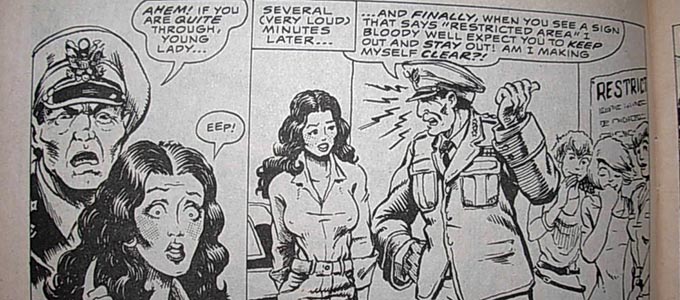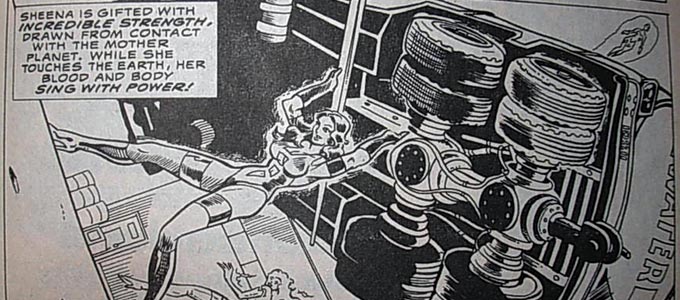This page may contain one or more affiliate links, which means that if you purchase a product through that link, I may receive compensation. The links will be identified with the text "affiliate link". Click to learn more.
Some people like to ridicule Sultry Teenage Super Foxes for its incredibly obvious sexual theme, but we all know those people bought the comic for the same reason: because we wanted to see some Sultry Teenage Super Foxes! I was able to get the first issue. I came across it while researching short-lived publisher Solson. Some blame the lack of subtlety on Gary Brodsky, president of Solson, but as far as I can tell, he really had nothing to do with this comic. It clearly states that this comic was created by Rich Buckler, and even lists his name as the publisher.
The plot of Sultry Teenage Super Foxes is that four teenage girls are hanging around an air force base for the summer. You can tell this comic was published in the 1980’s because one girl is sporting the Pat Benatar look, and another has the Flashdance shirt-on-one-shoulder look. There is a really weird panel where the girls are looking at a nerd and one imagines the person with a number 2 pencil in place of his head. I have no idea what this means or implies. Anyway, the girls find a “matter transmutation device” that can literally change dog crap to gold, and use it to transform themselves into having super powers. Meanwhile, some woman elsewhere had become possessed by an evil spirit while astral projecting, and…. well, you see where this is going.
This comic is in black and white, reminiscent of others such as Strangers in Paradise, and the drawings are usually decent. The appeal of black and white comic book stories lies in their ability to convey powerful narratives through a visually striking medium. Stripped of color, these tales rely on the intricate interplay of light and shadow, as well as the skillful use of line work and texture, to bring their stories and characters to life. Furthermore, the monochromatic style adds a layer of depth and sophistication to the storytelling, inviting readers to interpret the nuances of each panel in their own unique way. By embracing the simplicity and artistic purity of black and white illustrations, these comic book stories manage to captivate audiences and stand the test of time.
Rich Buckler’s artwork stands out as a testament to his incredible talent and keen eye for detail, particularly in his portrayal of women. His illustrations display a combination of strength, grace, and beauty, capturing their essence with an almost uncanny ability. Buckler’s unique approach to depicting women not only highlights their power and resilience but also emphasizes their complexities as individuals. This focus on authenticity and depth has led to a lasting impact on the world of art and a devoted following for his work.
The main characters are very two-dimensional, and don’t reveal much about themselves. While some might see this comic as trashy, It is interesting enough to be a collectible worth owning (Affiliate Link). Solson has a history in comics, publishing other curious titles such as Samurai Santa. The creator, of Sultry Teenage Super Foxes, Rich Buckler has an even richer history, and has penciled countless comic books. Let me close by saying this: one hilarious detail about this comic is that at the end of the story, there is an advertisement…. for the exact same comic and issue!

About Solson Publications
Solson Publications was a black-and-white comic book publisher from New York that operated in the 80s and was reestablished during the late 90s. It was established by Gary Brodsky, who was Sol Brodsky’s son; Solson is a portmanteau derived from his father’s name. Quite clever, isn’t it?
Solson Comics released a series of unusual and funny books in those days, mostly with some reference or parody of Eastman and Laird’s Teenage Mutant Ninja Turtles. Some examples were The Bushido Blade of Zatoichi Walrus, Leonardo (not the turtle, but a guy who looked like him), and Samurai Funnies. They even had an Xmas special with Samurai Santa, which was inked by a young Jim Lee (yes, that Jim Lee).
Reagan’s Raiders is one of the titles that come to mind as perhaps the most infamous, with President Ronald Reagan and his cabinet members portrayed as costumed adventurers in the style of Nick Fury and his Howling Commandos. These stalwartly battled communists, terrorists, and drug lords with handguns, grenades, and thunderous slogans. This graphic novel was so wild that it was hard to know if it was poking fun or paying homage.
There are a certain number of how-to books written by Solson published in the field of the comics business as well; they also contain art from Rich Buckler. A few seem genuinely useful, for instance, “How to Become A Comic Book Artist” and “How to Draw Super-Heroes.”
The Artist Rich Buckler
Renowned for his work in the world of comic art, he developed an interest in drawing at a young age and had begun to sell his work to local comic book publishers before turning 15.
It was Buckler’s first big break in 1974 when Marvel Comics hired him to be on the staff for their series, Fantastic Four. His distinctive style and ability to provide minutely drawn graphics quickly caught the attention of the readership, and shortly after, he became a popular favorite. Additionally, he found himself working on some of Marvel’s other flagship titles such as The Avengers, Spectacular Spider-Man, and X-Men.
One distinguishing factor between Buckler and other comic artists was the creation of dynamic, highly kinetic panels. In his art, there was a lot of energy and action, which gave life to the heroes on the page. Moreover, he used to make very intricate backgrounds and environments that would add so much depth and realism to his stories.
Aside from his involvement in Marvel, Buckler also left a mark on DC Comics. He was responsible for Superman, Justice League, and Teen Titans. He even introduced a new hero, Deathlok, for Marvel, which eventually skyrocketed to fame within the comic book industry.
Buckler’s influence on the comic book industry extends beyond his artwork. He was also a teacher, having helped many young artists perfect their skills. He even co-founded the Detroit Triple Fan Fair, which united comic book fans and creators in his hometown.
It was unfortunate that on the 19th of May 2017, a sad event took place; Rich Buckler died at the age of 68. Yet even though he has passed, his legacy remains alive through the artistry he gifted and the influence he exerted upon his contemporaries. He shall always be one in a thousand, and nobody will forget him as a brilliant and innovative comic artist who made an indelible impression on this field.

